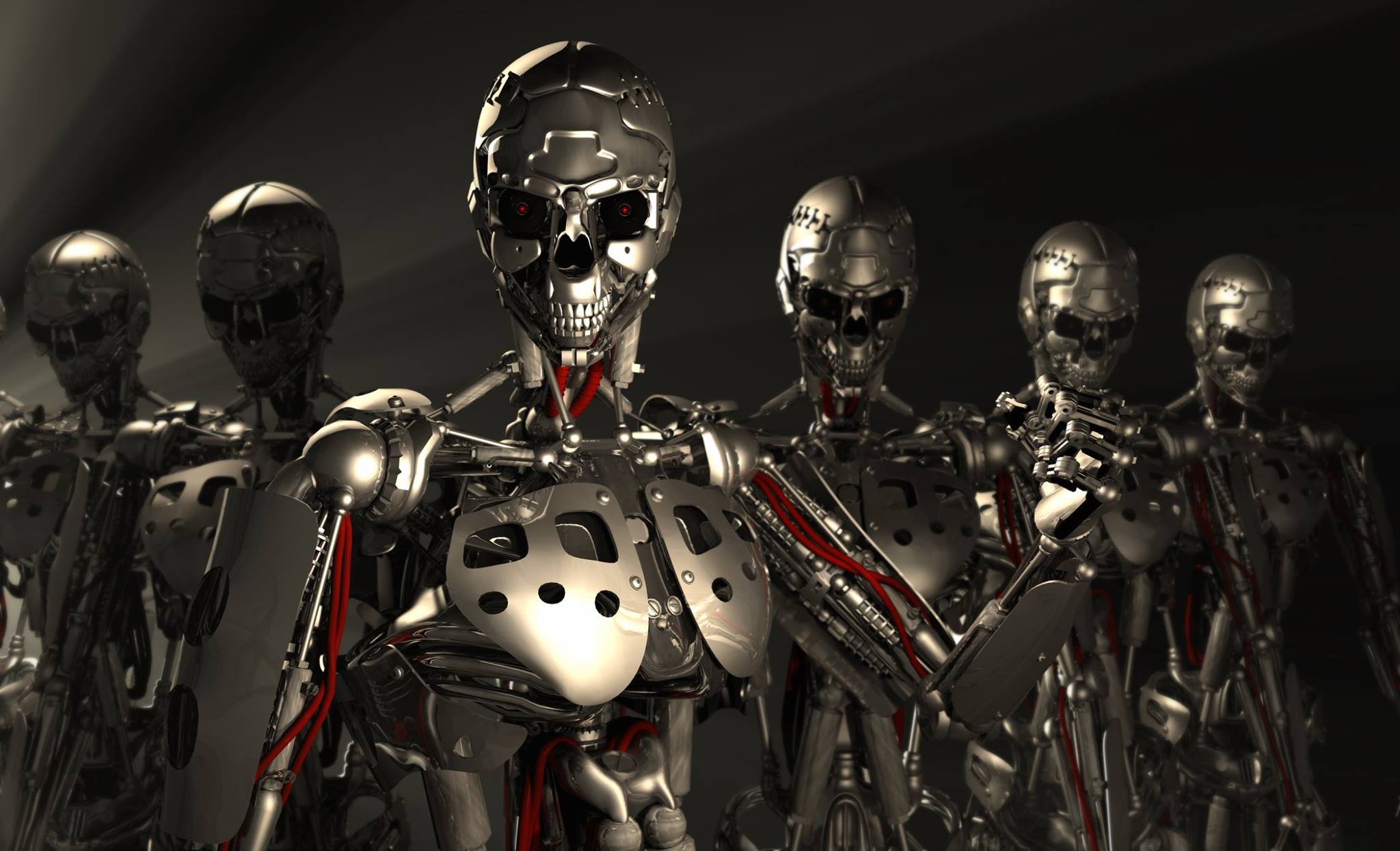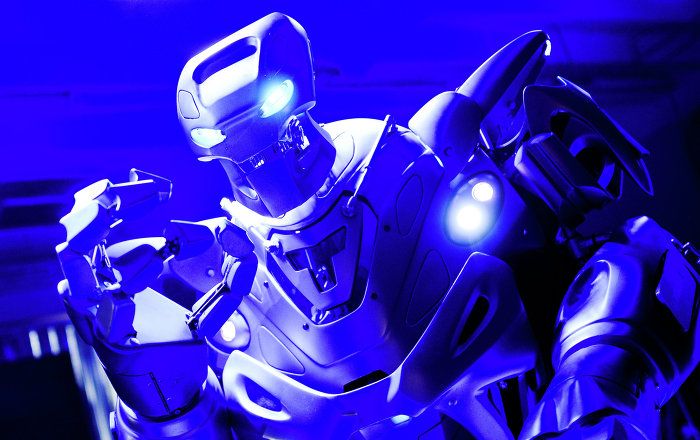https://vimeo.com/53577644
Economist Carlota Perez talk about the future of ICT.
https://vimeo.com/53577644
Economist Carlota Perez talk about the future of ICT.

Despite more than a thousand artificial-intelligence researchers signing an open letter this summer in an effort to ban autonomous weapons, Business Insider reports that China and Russia are in the process of creating self-sufficient killer robots, and in turn is putting pressure on the Pentagon to keep up.
“We know that China is already investing heavily in robotics and autonomy and the Russian Chief of General Staff [Valery Vasilevich] Gerasimov recently said that the Russian military is preparing to fight on a roboticized battlefield,” U.S. Deputy Secretary of Defense Robert Work said during a national security forum on Monday.
Work added, “[Gerasimov] said, and I quote, ‘In the near future, it is possible that a complete roboticized unit will be created capable of independently conducting military operations.’”

Google is reportedly planning to spin off its self-driving car division and offer autonomous taxi rides.

Facebook announced that its latest artificial intelligence (AI) server designs will be made open source, continuing on the company’s course of letting others share new hardware designs, which it began back in 2011. Codenamed Big Sur, the server is designed to train the newest class of deep learning AI that mimic the human brain’s neural pathways.

“When will I have a robot that can do my laundry?”
This is the number one question I get from friends and family members, whose expectations are unconstrained by the software and hardware technical realities that make robots tick (washing dishes is a close second by the way).
Since most have been waiting a lifetime for this transformational milestone, I have been promising lately, with muted bravado, that it won’t be too long now.

Wait, what? You might be asking yourself what inspired a hacker by the name of George Hotz to build his own self-driving car. That’s what we wanted to know, too. It would seem that Hotz decided to kick out a self-driving car using a 2016 Acura ILX in “about a month.” He’s using Ubuntu Linux as his operating system and has an absurdly massive 21.5-inch display sitting in the middle. A flight navigator joystick rests between the front two seats which, when triggered, engages a fully operational self-driving vehicle system.
Hots spoke with Bloomberg earlier this year for a report this week, showing reporters what his vehicle can do out on the highway back a few days before Thanksgiving. The vehicle is nowhere near a production-level sort of setup, looking more like Hotz ripped the cords out of several machines and bashed them together inside his vehicle — but it works. It all works.
“Don’t touch any buttons, or we’ll die,” said Hotz to his guests before they hit the road. Watch the video below to see what’s going on:

The news this month is full of stories about money pouring into AI research. First we got the news about the $15 million granted to the new Leverhulme Center for the Future of Intelligence. Then Elon Musk and friends dropped the news about launching OpenAI to the tune of $1 billion, promising that this would be a not-for-profit company committed to safe AI and improving the world. But that all pales in comparison to the $12-$15 billion that the Pentagon is requesting for the development of AI weapons.
According to Reuters, “The Pentagon’s fiscal 2017 budget request will include $12 billion to $15 billion to fund war gaming, experimentation and the demonstration of new technologies aimed at ensuring a continued military edge over China and Russia.” The military is looking to develop more advanced weapons technologies that will include autonomous weapons and deep learning machines.
While the research itself would be strictly classified, the military wants to ensure that countries like China and Russia know this advanced weapons research is taking place.

Hollywood has long warned about the dangers of artificially intelligent robots. Now the Pentagon is thinking about future autonomous armies, and the possibility that it’s falling behind Russia and China in the race for weaponized artificial intelligence (AI).
In the various incarnations of Douglas Adams’ Hitchhiker’s Guide To The Galaxy, a sentient robot named Marvin the Paranoid Android serves on the starship Heart of Gold. Because he is never assigned tasks that challenge his massive intellect, Marvin is horribly depressed, always quite bored, and a burden to the humans and aliens around him. But he does write nice lullabies.
While Marvin is a fictional robot, Scholar and Author David Gunkel predicts that sentient robots will soon be a fact of life and that mankind needs to start thinking about how we’ll treat such machines, at present and in the future.
For Gunkel, the question is about moral standing and how we decide if something does or does not have moral standing. As an example, Gunkel notes our children have moral standing, while a rock or our smartphone may not have moral consideration. From there, he said, the question becomes, where and how do we draw the line to decide who is inside and who is outside the moral community?
“Traditionally, the qualities for moral standing are things like rationality, sentience (and) the ability to use languages. Every entity that has these properties generally falls into the community of moral subjects,” Gunkel said. “The problem, over time, is that these properties have changed. They have not been consistent.”
To illustrate, Gunkel cited Greco-Roman times, when land-owning males were allowed to exclude their wives and children from moral consideration and basically treat them as property. As we’ve grown more enlightened in recent times, Gunkel points to the animal rights movement which, he said, has lowered the bar for inclusion in moral standing, based on the questions of “Do they suffer?” and “Can they feel?” The properties that are qualifying properties are no longer as high in the hierarchy as they once were, he said.
While the properties approach has worked well for about 2,000 years, Gunkel noted that it has generated more questions that need to be answered. On the ontological level, those questions include, “How do we know which properties qualify and when do we know when we’ve lowered the bar too low or raised it too high? Which properties count the most?”, and, more importantly, “Who gets to decide?”
“Moral philosophy has been a struggle over (these) questions for 2,000 years and, up to this point, we don’t seem to have gotten it right,” Gunkel said. “We seem to have gotten it wrong more often than we have gotten it right… making exclusions that, later on, are seen as being somehow problematic and dangerous.”
Beyond the ontological issues, Gunkel also notes there are epistemological questions to be addressed as well. If we were to decide on a set of properties and be satisfied with those properties, because those properties generally are internal states, such as consciousness or sentience, they’re not something we can observe directly because they happen inside the cranium or inside the entity, he said. What we have to do is look at external evidence and ask, “How do I know that another entity is a thinking, feeling thing like I assume myself to be?”
To answer that question, Gunkel noted the best we can do is assume or base our judgments on behavior. The question then becomes, if you create a machine that is able to simulate pain, as we’ve been able to do, do you assume the robots can read pain? Citing Daniel Dennett’s essay Why You Can’t Make a Computer That Feels Pain, Gunkel said the reason we can’t build a computer that feels pain isn’t because we can’t engineer a mechanism, it’s because we don’t know what pain is.
“We don’t know how to make pain computable. It’s not because we can’t do it computationally, but because we don’t even know what we’re trying to compute,” he said. “We have assumptions and think we know what it is and experience it, but the actual thing we call ‘pain’ is a conjecture. It’s always a projection we make based on external behaviors. How do we get legitimate understanding of what pain is? We’re still reading signs.”
According to Gunkel, the approaching challenge in our everyday lives is, “How do we decide if they’re worthy of moral consideration?” The answer is crucial, because as we engineer and build these devices, we must still decide what we do with “it” as an entity. This concept was captured in a PBS Idea Channel video, an episode based on this idea and on Gunkel’s book, The Machine Question.
To address that issue, Gunkel said society should consider the ethical outcomes of the artificial intelligence we create at the design stage. Citing the potential of autonomous weapons, the question is not whether or not we should use the weapon, but whether we should even design these things at all.
“After these things are created, what do we do with them, how do we situate them in our world? How do we relate to them once they are in our homes and in our workplace? When the machine is there in your sphere of existence, what do we do in response to it?” Gunkel said. “We don’t have answers to that yet, but I think we need to start asking those questions in an effort to begin thinking about what is the social status and standing of these non-human entities that will be part of our world living with us in various ways.”
As he looks to the future, Gunkel predicts law and policy will have a major effect on how artificial intelligence is regarded in society. Citing decisions stating that corporations are “people,” he noted that the same types of precedents could carry over to designed systems that are autonomous.
“I think the legal aspect of this is really important, because I think we’re making decisions now, well in advance of these kind of machines being in our world, setting a precedent for the receptivity to the legal and moral standing of these other kind of entities,” Gunkel said.
“I don’t think this will just be the purview of a few philosophers who study robotics. Engineers are going to be talking about it. AI scientists have got to be talking about it. Computer scientists have got to be talking about it. It’s got to be a fully interdisciplinary conversation and it’s got to roll out on that kind of scale.”

Robot doctors, virtual reality vacations and smart toothbrushes. These are just a few of the things the world can expect to see in the not-so-distant future, says Stanford and Duke researcher and lecturer Vivek Wadhwa.
Speaking to a crowd of more than 300 people in Palm Beach in December at billionaire Jeff Greene’s “Closing the Gap” conference, which addressed the growing divide between the wealthy and poor and how the rise of machines might kill white-collar jobs, Wadhwa sketched a sci-fi vision for the future that he says will soon be a reality thanks to rapid technological innovation.
“The future is going to be happening much, much faster than anyone ever imagined,” said Wadhwa, explaining that tech growth has been exponential — meaning as technology advances it does so with increasing speed.